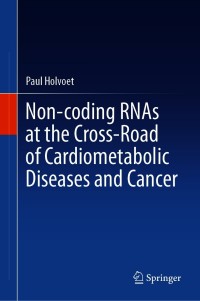Buy Non-coding RNAs at the Cross-Road of Cardiometabolic Diseases and Cancer PDF ebook by author Paul Holvoet – published by Springer in 2021 and save up to 80% compared to the print version of this textbook. With PDF version of this textbook, not only save you money, you can also highlight, add text, underline add post-it notes, bookmarks to pages, instantly search for the major terms or chapter titles, etc.
You can search our site for other versions of the Non-coding RNAs at the Cross-Road of Cardiometabolic Diseases and Cancer PDF ebook. You can also search for others PDF ebooks from publisher Springer, as well as from your favorite authors. We have thousands of online textbooks and course materials (mostly in PDF) that you can download immediately after purchase.
Note: e-textBooks do not come with access codes, CDs/DVDs, workbooks, and other supplemental items.
eBook Details:
Full title: Non-coding RNAs at the Cross-Road of Cardiometabolic Diseases and Cancer
Edition:
Copyright year: 2021
Publisher: Springer
Author: Paul Holvoet
ISBN: 9783030688448, 9783662630266
Format: PDF
Description of Non-coding RNAs at the Cross-Road of Cardiometabolic Diseases and Cancer:
This book gives insight into the functional role of non-coding RNAs in central pathways contributing to the development of obesity, type 2 diabetes, non-alcoholic fatty liver disease, atherosclerosis, myocardial infarction, cardiomyopathy, and heart failure. It also sheds light on the relationship of this cluster with cancer. Tumor cells, in contrast to cells in cardiometabolic tissues, can regulate this cluster of non-coding RNAs to escape from oxidative stress and anti-tumor immunity and maintain insulin sensitivity, facilitating cancer progression. The book presents a cluster of non-coding RNAs that may be prospectively analyzed in extensive cohort studies to determine their value in risk-predicting machine learning algorithms. In addition, it emphasizes the role of microvesicles in communication between tumor-adjacent tissue, inflammatory cells, and tumor cells, with a special focus on the role of miR-155. The book intends to promote interdisciplinary research. Due to the comprehensive background information provided in each chapter, it is suitable for researchers in academia and industry and for graduate students in biology, bioengineering, and medicine.





